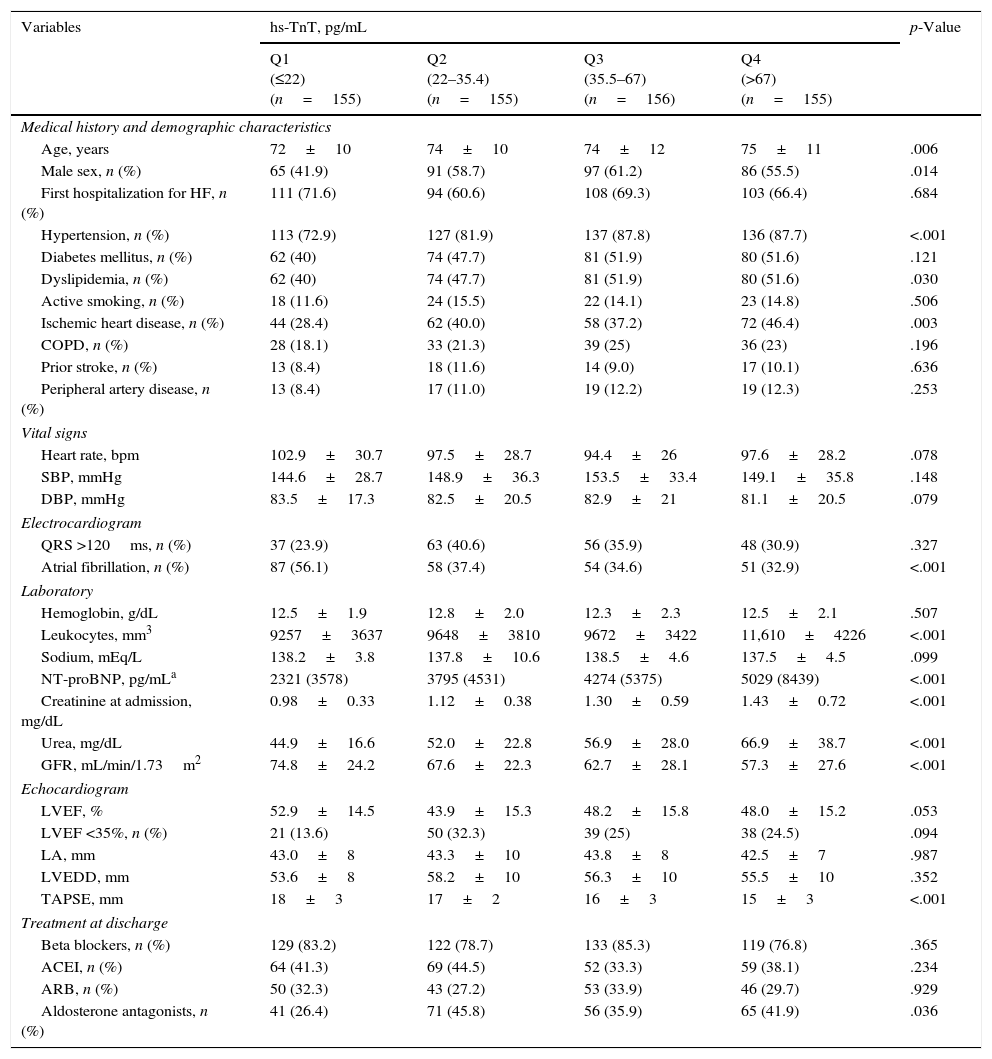High-sensitivity troponin is a biomarker of myocardial damage and is associated with a greater risk of mortality and disease progression in patients with acute heart failure (AHF). However, its relationship with the risk of future readmissions is less known. The aim of this study was to assess the association between ultrasensitive troponin T (TnT-us) values in patients with AHF and the risk of recurrent readmissions in the follow-up.
MethodsWe prospectively included a cohort of 621 consecutive patients with AHF, excluding those patients with acute coronary syndrome. We measured the TnT-us levels obtained during the first medical contact in the emergency department. The risk of cumulative readmissions was assessed using negative binomial regression.
ResultsThe mean age of the participants was 73.6±10.8 years, 54.6% were men, and 52% had a left ventricular systolic function ≥50%. The median TnT-us level was 35.5pg/mL (interquartile range [IQR], 22–67). After a median follow-up of 1.2 years (IQR, 0.4–2.4), a total of 153 deaths (24.6%) were recorded, as well as 689 readmissions for all causes in 303 patients (48.8%) and 286 readmissions for HF in 163 patients (26.3%). In the multivariate analysis, the high TnT-us values were associated with an increased risk of readmission, both for all causes and for HF (incidence rate ratio [IRR], 1.16; 95% CI, 1.02–1.36; p=.029 and IRR, 1.23; 95% CI, 1.04–1.46; p=.018, respectively).
ConclusionsFor patients with AHF, the increase in TnT-us levels was independently associated with a risk of recurrent readmissions during the follow-up.
La troponina de alta sensibilidad es un biomarcador de daño miocárdico que se asocia a un mayor riesgo de mortalidad y progresión de la enfermedad en pacientes con insuficiencia cardíaca aguda (ICA). Sin embargo, su relación con el riesgo de futuras rehospitalizaciones es menos conocido. El objetivo de este estudio fue evaluar la asociación entre los valores de troponina T ultrasensible (TnT-us) en pacientes con ICA y el riesgo de hospitalizaciones recurrentes en el seguimiento.
MétodosSe incluyó prospectivamente una cohorte de 621 pacientes consecutivos con ICA, excluyéndose pacientes con síndrome coronario agudo. Se determinó la TnT-us obtenida en el primer contacto médico en urgencias. El riesgo de reingresos acumulados se evaluó mediante regresión binomial negativa.
ResultadosLa edad media de los sujetos fue de 73.6±10,8 años, el 54,6% eran varones y el 52% tenían una función sistólica ventricular izquierda ≥50%. La mediana de TnT-us fue de 35,5pg/ml (rango intercuartílico [RI]=22–67). Tras una mediana de seguimiento de 1,2 años (RI= 0,4–2,4) se registraron 153 muertes (24,6%), 689 reingresos por todas las causas en 303 pacientes (48,8%), y 286 reingresos por IC en 163 pacientes (26,3%). En el análisis multivariante, los valores elevados de TnT-us se asociaron con un aumento del riesgo de reingreso, tanto por todas las causas como por IC (cociente de las tasas de incidencia [IRR] =1,16; intervalo de confianza del 95%, 1,02-1,36; p=0,029; IRR=1,23; intervalo de confianza del 95%, 1,04-1,46; p= 0,018, respectivamente).
ConclusionesEn pacientes con ICA, el aumento de los valores de TnT-us se asoció de manera independiente con el riesgo de hospitalizaciones recurrentes durante el seguimiento.
Article
Diríjase desde aquí a la web de la >>>FESEMI<<< e inicie sesión mediante el formulario que se encuentra en la barra superior, pulsando sobre el candado.

Una vez autentificado, en la misma web de FESEMI, en el menú superior, elija la opción deseada.

>>>FESEMI<<<









